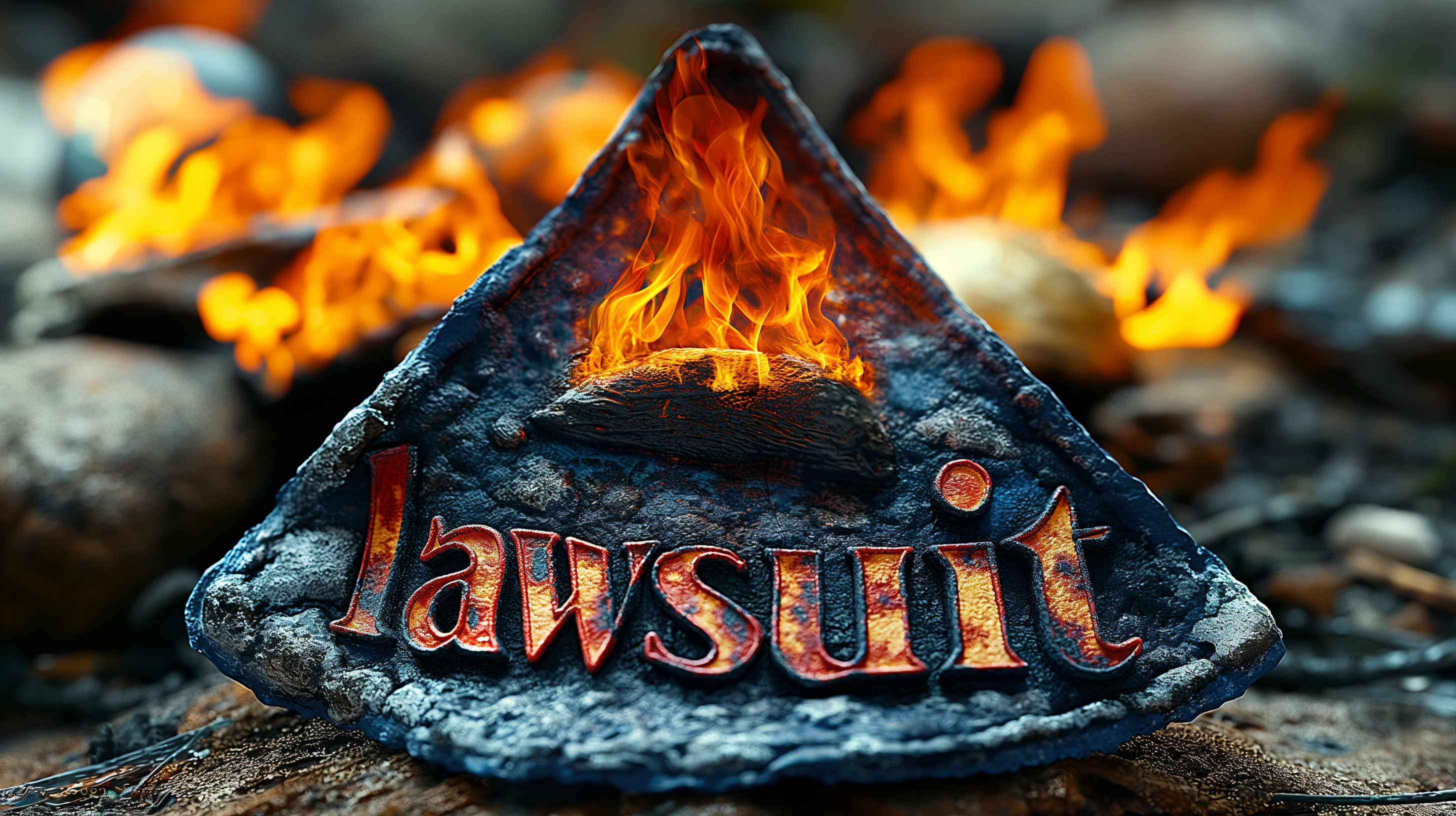
The Paqui One Chip Challenge lawsuit exposes the dangers of viral food trends and corporate negligence. Understand the legal battle's key issues and learn how to protect yourself and loved ones from potentially harmful product challenges.
by LawInc Staff
July 11, 2024
The tragic death of 14-year-old Harris Wolobah after participating in the viral “One Chip Challenge” has sparked a high-profile wrongful death lawsuit against the chip’s makers and distributors. This guide breaks down the key facts, legal issues, defendants’ potential liability, and important takeaways from this heartbreaking case.
From the chip’s extreme spiciness to its cartoon packaging appealing to youth to the social media “challenge” aspect and more, gain an in-depth understanding of the complex web of factors that could make this product unreasonably dangerous, especially for children. We’ll also examine each of the multiple causes of action alleged, from negligence to breach of warranty to willful/wanton conduct, and the elements that must be proven.
While nothing can undo this family’s unimaginable loss, the case sheds light on important issues of corporate responsibility, product labeling, and protecting kids from dangerous viral trends.
1. Basic Case Facts
-
- The Chip: A single tortilla chip named the 2023 “One Chip Challenge”, consisting of extremely spicy Carolina Reaper and Naga Viper peppers, produced by Paqui, LLC, Amplify Snack Brands, Inc., and The Hershey Company.
- The Incident: Harris, 14, ate the chip on 9/1/23 at school after a friend bought it. He suffered severe reactions including stomach pain and confusion, eventually experiencing cardiac arrest and was declared dead at the hospital.
- The Defendants: Chip makers Paqui, LLC, parent co. Amplify Snack Brands, owner The Hershey Co., plus Walgreens entities and employees James Connolly and Jane Doe who sold the chip.
- The Plaintiff: Harris’ mother Lois Lama Wolobah, suing as representative of his estate for wrongful death and survival action claims.
- Causes of Action: Negligence, product defects, breach of implied warranties of merchantability and fitness for a particular purpose, willful/wanton/reckless conduct, failure to warn and more against various defendants.
Key Allegations:
-
- The chip contained a dangerous level of capsaicin, the chemical in peppers that makes them spicy and acts as an irritant, with Carolina Reaper and Naga Viper peppers.
- Capsaicin can cause severe burning, pain, vomiting, stomach and heart issues, and even death as alleged here.
- The chip makers are accused of knowingly selling an unreasonably dangerous product, not adequately warning of risks, and marketing in an appealing way to kids.
- Walgreens allegedly improperly sold the chips to a minor without safeguards and in a way accessible to underage consumers.
- Viral “challenge” aspect encouraged risky consumption without medical precautions.
Importance & Broader Implications:
-
- Raises critical issues of corporate responsibility for products that may be inherently unsafe, even if legal, especially when marketed to and used by youth.
- Highlights dangers of viral social media “challenges” that can drive risky behavior without full awareness of hazards.
- Underscores need for clear, prominent warnings, age restrictions, and reasonable safeguards in selling certain products.
- Will hinge on where the line is drawn between known risks inherent to spicy foods vs. unreasonable danger based on extreme heat level.
- Implicates consumer and food safety laws and common law tort principles.
Key Facts & Figures:
-
- The Carolina Reaper and Naga Viper rank among the world’s hottest peppers at up to 2,000,000+ Scoville Heat Units (SHU). Jalapeños max out around 8,000 SHU.
- One Chip Challenge has been running since 2016, with multiple reports of teen injuries and hospitalizations in recent years.
- Capsaicin is the main ingredient in pepper spray, used as a chemical irritant weapon.
- There have been several past lawsuits involving unreasonably spicy foods causing injury as well as suits over dangerous social media challenges.
- Paqui/Amplify/Hershey are major snack food corporations with nationwide sales and substantial assets that could be at stake.
2. Examine the Multiple Causes of Action Alleged
-
- Negligence: Defendants breached a duty of care to Harris, causing his death. Elements are duty, breach, causation, damages.
- Strict Product Liability: The chip was defective and unreasonably dangerous in design, manufacture, or warnings, making it unsafe for intended use.
- Failure to Warn: Defendants didn’t adequately warn of risks or instruct on safe use, and the danger was not open and obvious.
- Breach of Warranties: The chip was not fit for its ordinary purpose (implied warranty of merchantability) or Plaintiff’s particular purpose of safe consumption.
- Willful/Wanton/Reckless Conduct: Defendants acted with reckless disregard or indifference to safety, warranting punitive damages.
Key Elements & Factors:
-
- Duty will likely be established – the question is what level of care was required for this type of product and whether it was breached.
- Design defect may be argued based on extreme spice level, but Defendants will say the risk is inherent to peppers and chip is legal.
- Warning defect has traction, as the existing cautions were vague and lacked specific medical risks. Youth appeal also undercuts effectiveness.
- Causation may be challenged – Defendants likely to argue pre-existing conditions and proper use would not cause this. Medical evidence is key.
- Recklessness may be a stretch for the chip makers but a stronger argument for Walgreens as the point-of-sale to a child.
Potential Defenses:
-
- Product is legal, known to be very spicy, and risks are inherent; no design or manufacturing defect.
- Warnings were provided, if imperfect. Danger of hot peppers is common knowledge; consumers assume the risk.
- Misuse by a child consumer contrary to the label and not intended use; parents should supervise.
- Lack of specific medical causation; spicy food alone would not cause this but for a pre-existing condition.
- No privity between consumer and some defendants for implied warranty claims.
Predicted Outcome:
-
- Case is likely to survive dismissal on at least some claims given sympathetic facts, but odds of total Plaintiff victory at trial are slim.
- There is a good chance of a settlement, as Defendants will want to avoid protracted litigation and publicity over a child’s death.
- Plaintiff has a strong argument on inadequate warnings and targeting/access to youth. Design defect and merchant liability are tougher.
- Causation could go either way – evidence so far suggests an extreme reaction, but medical records and expert testimony are needed.
- Most likely is a partial settlement with the chip makers disclaiming admission of fault plus more rigorous warnings and safeguards going forward.
3. Unpack the Negligence Theory Against Each Defendant
-
- Paqui & Amplify – Makers: Manufactured an unsafe product, did not adequately warn or guard against risks, and marketed a dangerous “challenge.”
- Hershey – Parent Company: Knew of issues after acquiring chip brands but still allowed production and promotion of unsafe product.
- Walgreens Entities – Sellers: Sold a dangerous product improperly to a child without safeguards, age verification, or access restrictions.
- James Connolly – Store Manager: Allowed display/sale of One Chip Challenge to minors and failed to ensure underage customers could not buy it.
- “Jane Doe” – Store Employee: Negligently sold the chip directly to Harris’ friend without verifying age or providing warnings.
Factors Affecting Liability:
-
- Foreseeability of harm is a key factor – Defendants will argue a death was not a foreseeable result of spicy chip consumption.
- It matters whether this was a known or foreseeable hazard at the time of manufacture vs. a later-discovered danger.
- Prior similar incidents and safety complaints could show notice of the risk supporting a duty to do more.
- Defendants will likely argue superseding cause and shift blame, e.g. chip makers faulting Walgreens, all faulting lack of parental supervision.
- Plaintiff has strongest duty arguments against Walgreens – retailers must act reasonably to avoid selling certain products to minors.
Proving Causation:
-
- Medical records, autopsy report, and death certificate must show injuries were caused by the chip ingredients and not other health issues.
- Expert medical testimony will be necessary in establishing specific causation and rule out alternate causes.
- Defendants may argue Harris had an atypical, unforeseeable reaction or pre-existing condition that was the real cause.
- Evidence of consumption, proximity to onset of symptoms, and link to eventual cardiac arrest and death is crucial.
- Mere temporal connection is not enough – must show chip more likely than not directly caused or substantially contributed to death.
Apportioning Fault:
-
- Comparative fault principles will apply – the jury can assign percentages of responsibility to each party.
- Makers may argue retailer bears most fault for allowing sale to minor; vice versa, Walgreens may say product is the problem.
- Defendants will try to cast some blame on Harris, his parents, and his friend who bought the chip as well.
- A small amount of comparative fault assigned to Harris would not bar recovery but would reduce damages proportionally.
- Joint and several liability rules will govern how much each Defendant might ultimately owe if found liable.
4. Analyze the Product Liability & Failure to Warn Claims
-
- Design Defect: The chip may be defective if the extreme spice level makes it unreasonably dangerous, taking into account the utility vs. risk.
- Manufacturing Defect: The individual chip eaten may have deviated from intended design and had more capsaicin than specified. Testing could show this.
- Warning Defect: Chip may be defective if risks were not apparent to consumers and warnings were inadequate to alert them to the hidden dangers.
- Marketing Defect: Chip may be defective in how it was marketed, if promotional “challenge” aspect encouraged unsafe use by kids.
- Failure to Warn: Defendants are liable if they did not adequately instruct on safe use or warn of non-obvious risks, and this caused Harris’ death.
Elements & Evidence:
-
- Plaintiff must show existence of a defect in the product’s design, manufacture, warnings or marketing at the time it left Defendant’s control.
- Defect can be established through direct evidence, circumstantial evidence, or expert testimony inferring a defect.
- Risk-utility test balances likelihood and severity of harm against burden of an alternative design and adverse consequences of a change.
- The consumer expectations test considers whether the product performed as safely as an ordinary consumer would expect.
- For warnings, key is showing Defendant knew or should have known of risk and it was not obvious, so a warning was needed.
Defenses to Product Liability:
-
- Product was not defective – met government standards, conformed to industry custom, and had high utility that outweighed risks.
- Plaintiff misused product contrary to warnings and in an unforeseeable or unreasonable way by letting a child access it.
- Danger was open and obvious to a reasonable consumer, especially as to spiciness. Only latent defects require additional warnings.
- Adequate warnings were given – “keep out of reach of children,” not for those with medical conditions, seek help for severe reactions, etc.
- No causation – the defect, rather than the inherent nature of the product, must have directly caused the specific injury at issue.
Potential Scope of Liability:
-
- Manufacturers are typically strictly liable for defective products regardless of fault. Retailers may be too unless sealed/no notice.
- All entities in the chain of distribution can be liable, from makers to suppliers to sellers, with some exceptions.
- Parent company Hershey likely has sufficient control/involvement to be liable along with subsidiary chip makers.
- Individuals like store managers and employees usually are not personally liable absent an independent duty, but employer is vicariously liable.
- Amount of damages will depend on strength of causation evidence for injury and extent of each Defendant’s fault allocated by the jury.
5. Parse the Breach of Warranty Theories
-
- Implied Warranty of Merchantability: By selling the one chip, Defendants warranted it was fit for its ordinary use.
- Implied Warranty of Fitness for Particular Purpose: If seller had reason to be aware of a particular purpose and buyer relied on them to furnish a suitable product, implied warranty it is fit for that purpose.
- Elements: Goods were subject to implied warranty, they were defective when sold and breach caused injury, buyer used product as intended, seller had notice of defect but did not cure.
- Key Facts: One Chip Challenge may not have been safe, wholesome and fit for human consumption if it contained unreasonably dangerous levels of capsaicin.
- Defenses: Implied warranties can be disclaimed or limited by conspicuous writing, or defect may have been caused by misuse rather than present at sale.
Implied Warranty of Merchantability:
-
- Applies to all sellers of the product who are merchants with respect to goods of that kind, like Paqui and Walgreens.
- Requires showing One Chip Challenge was not fit for the ordinary purpose of human consumption when sold.
- Buyer must prove goods were defective when they left the seller’s possession, causing personal injury/property damage.
- No privity required in most states for personal injury cases – end user can sue upstream sellers like manufacturers.
- Defendants may argue capsaicin level does not render chip unfit for consumption as super-spicy chips are now commonplace.
Implied Warranty of Fitness for Particular Purpose:
-
- Requires the seller to have known the specific purpose for which the goods were needed.
- Also requires the buyer to prove they relied on the seller’s expertise to choose a suitable product.
- The “particular purpose” here would be consumption by someone with Harris’ age and health profile.
- Challenging to prove Walgreens or Paqui knew Harris specifically would eat the chips or had notice of his medical status.
- But there is an argument they should know children generally would access the chips and rely on product being safe for them.
Damages for Breach of Warranty:
-
- Both implied warranty theories allow recovery of damages proximately caused by the breach.
- This includes general damages like medical bills and pain and suffering, and special damages like lost wages.
- Punitive damages are not usually recoverable pursuant to a breach of warranty theory, however.
- Plaintiff must demonstratethe harm was caused by the defective nature of the product and not other causes.
- Defense may argue a child improperly consuming a clearly spicy chip contrary to warnings was an unforeseeable misuse.
6. Explore Potential Grounds for Punitive Damages
-
- What is Required: Defendants acted with malice, oppression, fraud, willful/wanton disregard for safety, or gross negligence.
- Higher Standard: Punitive damages require more than ordinary negligence – behavior must be egregious, reckless or intentional.
- Burden of Proof: Usually needs “clear and convincing evidence,” which is stricter than the preponderance of the evidence standard.
- Purpose: To punish reprehensible conduct and deter future misdeeds. Usually not covered by insurance.
- Defenses: No actual knowledge of the risk of harm, attempted to give warnings even if inadequate, did not intend to cause injury.
Potential Allegations:
-
- Defendants knew of prior hospitalizations from One Chip Challenge but still marketed and sold it without better safeguards.
- Use of extremely spicy peppers like Carolina Reaper in a snack chip showed willful disregard for consumer safety.
- “Challenge” marketing aspect intentionally appealed to children and encouraged riskybehavior without proper warnings.
- Walgreens recklessly allowed the chips to be accessed and purchased by a minor with no age verification or warnings at point of sale.
- Defendants put profits over safety by continuing to sell a product they knew could cause severe harm to foreseeable child consumers.
Likelihood of Success:
-
- Punitive damages are often alleged to increase pressure, but they are awarded far less often than compensatory damages.
- Mere negligence or even gross negligence is usually not enough absent evidence of actual malice or intent to harm.
- Plaintiff has an uphill battle to show Defendants had evil motive or knew to a substantial certainty their actions would cause injury.
- General evidence the chip was very spicy and caused prior reactions likely won’t meet the “clear and convincing” bar for punitives.
- However, argument is stronger against Walgreens if Plaintiff can show a pattern of improper sales of dangerous products to minors.
Caps & Limitations on Punitive Damages:
-
- Many states impose caps or limits on punitive damage awards, such as a maximum ratio to the compensatory damages.
- The Supreme Court has suggested a 4:1 or 10:1 punitive to compensatory ratio is the outer limit of Due Process in most cases.
- Some states require a portion of punitive damages be paid to the state or a state fund rather than the plaintiff.
- Punitive damages are often reduced after trial by the court if they are deemed unconstitutionally excessive.
- So even if Plaintiff proves entitlement to some punitives here, the amount is likely to be significantly less than the compensatory award.
Summary & Key Takeaways for Consumers

The One Chip Challenge case is a sobering reminder of the serious risks that can arise from seemingly harmless social media trends, and the potential liability when companies market dangerous products without adequate safeguards.
As the first lawsuit of its kind involving a death allegedly caused by the viral One Chip Challenge, this case will be closely watched and could set an important precedent for future cases involving injuries from social media challenges and dangerous food products, especially as marketed to children.
While the legal outcome is far from certain and will depend heavily on the specific facts developed in discovery, the chip makers and Walgreens are facing an uphill battle defending a wrongful death suit centered on an underage consumer.
For consumers, this tragedy serves as a grim reminder to be extremely cautious with ultra-spicy snack foods, always read and heed all warning labels, and closely supervise children’s consumption of any potentially hazardous food products, especially those that seem intended to appeal to kids and teens.
When serious injuries happen, it’s vital to keep evidence, immediately notify all potentially liable parties, and consult an experienced attorney to protect your rights.
Full Lawsuit
Disclaimer
This article discussing the One Chip Challenge lawsuit is provided for general informational purposes only and does not constitute formal legal advice. Laws vary by jurisdiction and the legal analysis is based on the limited, publicly-available facts of this ongoing case at the time of publication.
For specific legal guidance, consult a licensed attorney in your state for a personalized case evaluation. Most personal injury law firms offer free, confidential consultations to advise you of your rights.
Related Articles
Texas Widow Sues Mexican Resort Over Husband’s Hot Tub Electrocution Death










